Welcome to our Folding @ Home team Green Sarawak page. We are proud to join this noble cause to help fighting various important diseases via donating our spare computer power into the distributed computer network for folding and unfolding of proteins lead by Stanford University.
| Folding@Home contribution stats for team GreenSarawak | |
|---|---|

|
|
| Team ID | 233758 |
| Grand score (points) | 15,312,775 |
| Work units completed | 1,206 |
| Team Ranking | 11,767 of 229,277 teams |
| Report generated on | 7th April 2024, 2:50 pm |
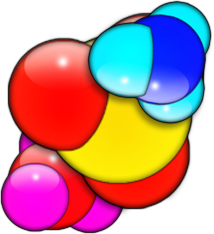
Folding@home allows anyone to assist with disease research by donating their unused computer processing power. To join in, simply download the F@H software. |
|
The Folding@home project (FAH) is dedicated to understanding protein folding, the diseases that result from protein misfolding and aggregation, and novel computational ways to develop new drugs in general.
Protein Folding
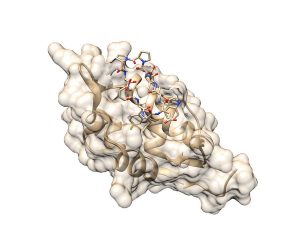
Before we jump into folding, lets know some basic. Proteins as we know of is the basic building blocks of all life. They are the structural elements of bones, muscles, hair, skin and blood vessels etc. These molecules in fact make up of long chains of amino acids that form a long chain that looks like a necklace in its naked form.
This long tiny strands of proteins don’t stay as a string of beads hanging from a stick, but been folded into a complex but yet specific shape that looks like a 3D origami pieces, with its shape forms specific function like a key and a lock to other substrates. Folding of protein is closely related to the genome that code and shape the protein.
It is just like origami, the steps of folding of protein need to be in their exact angle and portion, and since it is thousand times more complex than normal paper origami, errors tends to happen. One tiny mistake or misfolding will lead into total different configurations that render the protein shape to distorted and dysfunction. It was believed that these misfolding of proteins will lead to disease process such as Alzheimer’s disease, Huntington’s disease, cystic fibrosis, BSE (Mad Cow disease), an inherited form of emphysema, and even many forms of cancers.
Folding @ Home Distributed Computing
Protein folding can be mathematically simulated in a computer simulation, similarly to process of figuring how a paper should fold to form a final origami product.
Since the protein is a folded complex, each atoms in a protein chain can effectively affects the neighboring atoms, forming bonds and deflection, attraction and repulsion due to its electrical charges. Hence a real protein don’t stay static like a molded clay but constantly in fine motion and vibration. A glob of actively moving mass indeed.
The protein will always find a most comfortable shape and configuration to stay. However its state was always challenged by nearby substance, protein or even water molecule. Some protein contains area which is hydrophobic (hate water) will be defected further inwards due to present of water beside it.
Unlike origami which is a static process with one possible outcomes when all steps are replicated exactly the same in folding each paper. Protein folding is a dynamic process, two protein fold the same way will not end up the same result due to micro changes in the process. These micro changes however can be manipulated by a computer, and simulate differently.
More deeper information about how and why a protein fold can be find in their official website : http://folding.stanford.edu/dig-deeper/
The protein folding not only find how it was fold classically, but also can derive better understanding and open up new opportunity of folding of protein in order for future targeted therapy to be possible.
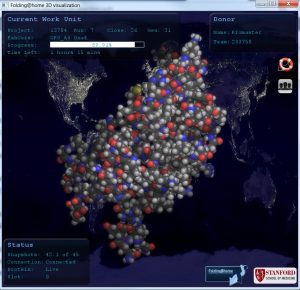
These computer simulations will required intense amount of computer process, which only can be done by super computers. However, to expand the resources away from the existing limited expensive super computer facility, more cheaper lower end computers can contribute together to complete the same task.
Well, we are not saying consumer personal computers are cheapos, but considering that national supercomputers are well funded and concentrated over more national critical workloads like military defense network, Oil prospecting, global weather simulation and forecasting etc. To get a good hold of processing power from renting a share from these super computer facility will be a lower priority for molecular simulation. Moreover the cost of a server hardware is >10 times more expensive than a consumer personal computer in comparison with the same computing power.
The parallelism of distributed computing and its distributive nature allow one major task to break down into smaller task that normal consumer computer can handle. One project can consist of many scenarios of simulation, e.g a single protein can fold in many was which can be manipulated with slight different in initial condition, which brought to many different outcomes. Hence each slight difference is addressed to different computer and together all computer will work towards an outcome which is most probable. (Protein folding dynamics is statistical in nature).
Distributive computing is not only seen in protein folding, other open source like BOINC also allow user to voluntary sponsor their computer power for distributed computing task like Einstein@Home, IBM World Community Grid, and SETI@home.
Similarly in the cryptocurrency world like bitcoin, the process of mining is tedious for a single computer to handle, and hence exist pool mining where everyone contributed parts of the share from a server that handles the pool and distribute the task to each computer connected to it. The miners will be rewarded based on their shares in the mining process.
Why the need to harvest unused computer power from the public ?
The concept is back to the idea that many computer is in idle state, which means not effectively producing any functional benefit but wasting energy. Most of our computer time will spend on non intensive task , such as movie watching, online, browsing photos, typing a spreadsheet, making a powerpoint, or just left in on just because feeling want to look at a amazing screensaver. No computer user will have 100% computer time used for intensive task like Gaming or movie editing all the time. Hence current computer is very much more powerful than what it is handling at real time.
Although these action don’t create much impact to a single computer, however these wasted computer times can add up to a very significant loss. A loss of energy, a loss of money, and increase the carbon footprint from power generation process.
Since the project is started up in year 2000, many project has added into the project list, which can be found in their official site : http://folding.stanford.edu/project-timeline/
In year 2016, a significant milestone had been reached, the folding@home had exceed 100PetaFLOPs of distributed computational power and continue to raise. The FLOPS is a measure of a computer’s performance, especially in fields of scientific calculations that make heavy use of floating point calculations.
To put that in perspective, 100PetaFLOPs is equivalent to A hundred quadrillion (or 100,000,000,000,000,000) floating point operations per second or been equal or more powerful that the world most power super computer in 2016 – The Sunway TaihuLight in Wuxi, China which have peak performance of over 125 PetaFLOPs.
So don’t underestimate your computer even it can only crunch 1 GigaFLOPs. It will add up in the masses.
Joining the Folding
Folding@home is run by an academic institution (specifically the Pande Group, at Stanford University’s Chemistry Department), which is a nonprofit institution dedicated to science research and education. Hence all action towards folding effort is voluntary. Just like donation to causes for humanity and needy.
Before you start, you can have a look at their official website for more information about folding. You can sit back and relax to decide if you wish to donate with a username or anonymously.
Username
To check if a name is already being used, use this search tool. It will redirect you to the Donor statistics on the folding at home official website.
Type your name above (where it says “YourName”) to see if that user name is already being used. You can also choose not to have a username and just donate your CPU time anonymously (user name = anonymous). The user name can contains only letters or numbers (to insert a space, you may use the underscore “_” character). User names are also case sensitive.
Since all the folding is voluntary, usernames are strictly for statistical purpose only. You can even use the existing usernames and you will end up having your points credited to that username. Anyway, you don’t earn for making billions of points in your donor statistics, except you can boast about how much had contributed to humanity to your friends.
In event of thinking of changing your username, you can’t change the old name (as it tie to the statistic), but you can create a new username which the point will be started from zero.
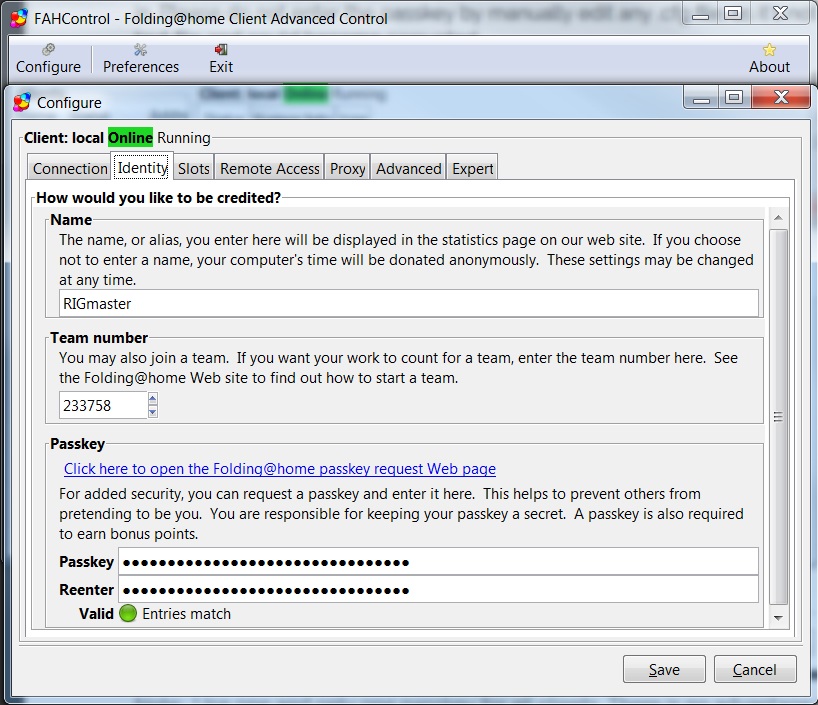
Passkey
Beginning with the v6.0 FAH client, user can get a unique passkey (unique identifier that ties your contributions directly to you) from the official website. Since one username can be shared by many people, there is issue with chances of black sheep in the group. One main benefit of passkeys is that if someone cheats, the points of everyone with that username will not zero out completely — only the offending party and those without passkeys that contributed the points will be removed.
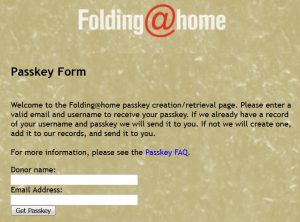
You can fold without passkey, but if you wish to get one, please go to http://fah-web.stanford.edu/cgi-bin/getpasskey.py and key in your username and email. They will send you the passkey to your email. The passkey request form is case sensitive.
If you had the passkey before and you forgets it, keying the same information (username and email) will send the same passkey to your email. If you key in different email, you will get a totally new passkey as it will consider a different person with same username.
Create a team

Creating a team is optional. If you want to join our GreenSarawak team, just key in the team ID as 233758 , however if you want to join other teams, you can go to the team statistic to find the team of interest and key in the team ID to your folding client.
If you wish to create a new team, go to http://fah-web.stanford.edu/cgi-bin/createteam.pl to create your own team and invite everyone in for folding.
The information needed are:
- New Team Name
- New Team Homepage URL (optional)
- New Team Logo URL (optional)
- Username (the username that will be used when need to change the team information later)
- Password (at least six characters)
- Email Address (when you forget the password)
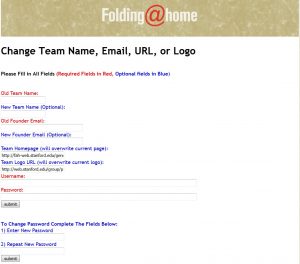
In Folding at Home, the team ID (number) is very crucial as anyone who wants to contribute their work unit toward a team should enter the team ID number in their client configuration instead of team name as the founder of the team can alter their team name, logo and homepage by entering the user name and password that they used to create the team.
To change a team information, you can go to http://fah-web.stanford.edu/cgi-bin/changeteam.pl
You can change the team name, email, team homepage, team logo and password from this section. You can’t change the username of the founder. Hence it is crucial to have a username that you can remember.
the Folding at home client
To have a access to the folding program, you can choose to install the desktop application or using the web browser app (only supported in google chrome).
Folding with the desktop folding at home software …
The folding at home client is a software that allows your computer to contribute into the distributive computing network. The client download can be found from http://folding.stanford.edu/start-folding/ or you can search through the alternative download page for clients for other operating system.
Supported operating systems includes:
- Windows (All versions)
- Mac OS X (Intel 10.6)
- 64 and 32 bit Linux (.deb + .rpm) – Debian / Mint / Ubuntu/Redhat / Centos / Fedora
Do click on the links above for the details of installations for each operating software.
The client is a lightweight software that acts as a bridge between the work unit distribution server and your personal computer. The addition engine required for the simulation of the work units will be download later when required by the simulation.

After installation, the Web Control (client manager) interface will start automatically after a few seconds. From there you will first encounter the change identity page. You can key in all the information that we had prepared earlier – the username, team ID (number) and the passkey. You have the option to left it blank if you just wish to fold anonymously under the username “Anonymous” and team number “0”.
Folding with the web browser …
When using the Chrome Browser you can run Folding@home without downloading the software to your computer or phone. Simply launch the app and start folding.
The Folding Power Slider
The software will run at the background, however you still have the control over how it use your resources. It is called the “Folding Power Slider”, which is available in the web control and the client advance control.


The slider controls how much system resources Folding@home uses. Adjust this level at anytime and the software will automatically reconfigure itself. There are three predefined power configurations allowing you to easily customize Folding@home performance from low to maximum.
Why this is somehow important ? it is because folding is an intensive simulation job, which will heat up your hardware significantly if you have a personal computer that is not adequately ventilate. A gamer will know that computer will crash if you stress a poorly ventilated computer with intense graphic simulation games.
Usually most gaming grade computer that can stand the torture of intense gaming will have adequate hardware supports to ensure that their computer don’t crash even with full folding power option. However if you are using regular laptop, mini computers with or low end computers without graphic card, you might need to stay at light folding power to stay responsive and safe.
The Power slider has three positions and two running options:
- Light
- CPU is Folding at half speed, GPU Folding is off.
- Medium
- CPU is Folding at three-quarter speed. GPU Folding is on. This is the default setting, and recommended for most users.
- Full
- CPU is Folding at full speed. GPU Folding is on. This is the most productive setting. Will cause fans to run faster and may produce more heat.
- While I’m working
- Folding is enabled to run at all times, based on the slider position.
- Only when idle
- Folding starts only when the system has not been used (no new mouse or keyboard input) for several minutes.
The Rewards
You don’t get financial or medals for voluntary contribution of computer power towards distributive computing, but you will credited with points for your hardwork. The points is determined by the performance of each contributor’s folding hardware (CPU, GPU, etc.) relative to a reference benchmark machine. The details of how points is rewarded can be found in their official faq : http://folding.stanford.edu/support/faq/points/
For general folks, the more points you have, the more you can brag about how much you had contributed to the folding. But besides bragging about the points you had, the most important thing is that you know that you have contributed to the needs of the research of diseases through the molecular simulation. That is the great part of what folding at home for. For humanity.
After 3 days of folding and we had a score of >1,500,000 points. Yeah !
So what are you hesitating ? Let’s folding at home now.
Join our team with ID : 233758
Article by RIGmaster
Information adapted from Folding@Home official website.


